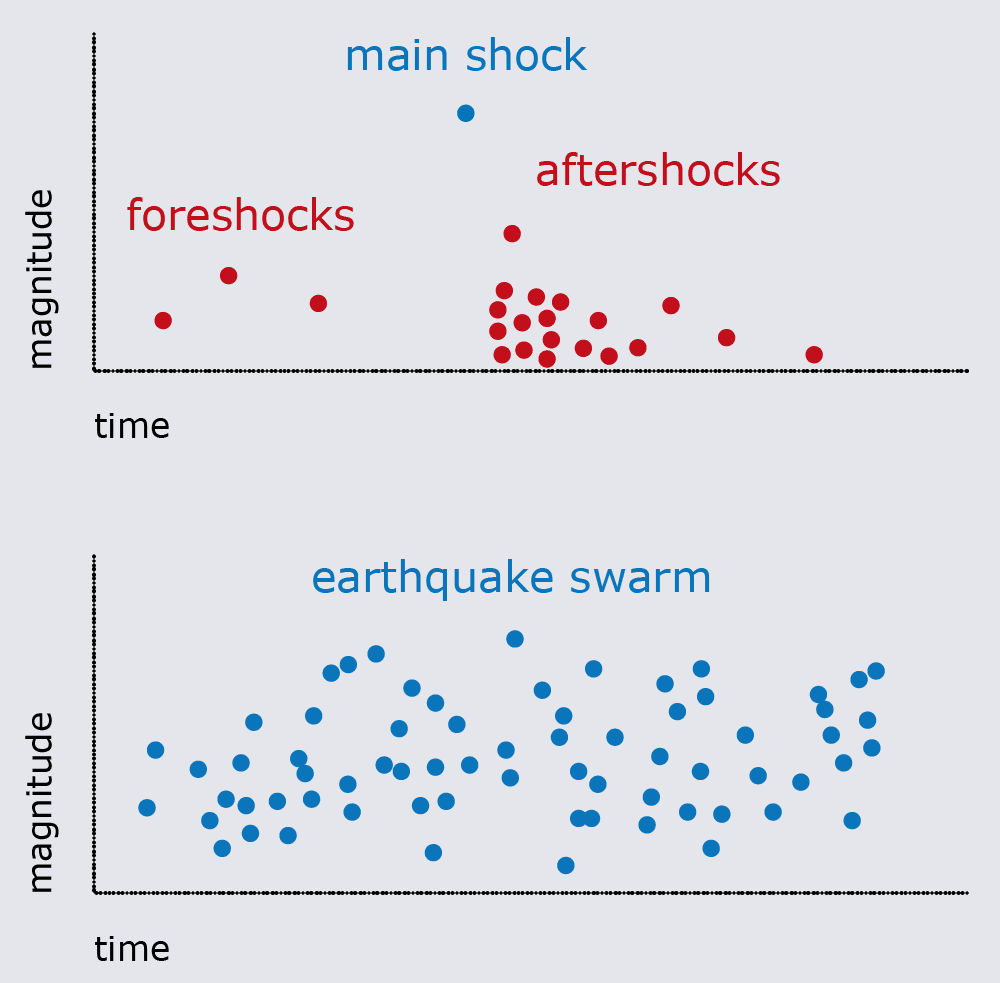Earthquake swarms are a series of earthquakes within a local area, occurring within a relatively short period. These swarms can occur over hours, days, weeks, and even months. They are different from earthquakes resulting in aftershocks, as no single earthquake can be identified as a clear mainshock in the sequence.
Generally, in a typical earthquake sequence, there are sometimes foreshocks, then the mainshock (the largest magnitude seismic event), and then an aftershock sequence (all seismic events proceeding with the largest registered magnitude earthquake).
These are rolling definitions, meaning that during the “aftershock sequence,” if a larger magnitude quake occurs in the same area at a similar depth, that would be considered the new mainshock. All previous quakes would become foreshocks, and subsequent smaller magnitude quakes are aftershocks.
In addition, there are no set definitions or periods of what constitutes a mainshock or foreshock. Based on current definitions, some of our recent large magnitude events (which occur in the same location and depth) of historical large magnitude seismic events can be considered part of that aftershock sequence.

Across the world, earthquake swarms occur, with hundreds to thousands of earthquakes spanning several months to years that could be directly attributed to a swarm. Seismic swarms often precede eruptions but only rarely precede large earthquakes. Generally, swarms are thought to result from ‘fault creep,’ when faults become unstuck and slide rapidly for some period, perhaps lubricated by the release of fluids.
The two most dominant hypotheses explaining the occurrence of earthquake swarms are the influence of magma and groundwater injection.
Magma (Volcanic) Earthquake Swarms
Most earthquake swarms are typically volcano-tectonic in the Eastern Caribbean, where volcanic islands exist. Volcano-tectonic earthquakes are earthquakes induced by the movement of magma or fluid underground. This movement can cause pressure changes, causing the surrounding rock to break or move and trigger minor earthquakes.
Read More
Volcanic Earthquakes
Fracking & Waste Water Injection Earthquake Swarms
In places like the United Kingdom and Oklahoma in the United States, wastewater disposal and (sometimes) fracking have induced earthquake swarms. In cases where hydraulic fracturing, also called fracking or underground wastewater disposal, induced earthquakes can happen. The cause of these earthquakes, according to the United States Geological Survey, are as follows:
“Earth’s crust is pervasively fractured at depth by faults. These faults can sustain high stresses without slipping because natural “tectonic” stress and the weight of the overlying rock push the opposing fault blocks together, increasing the frictional resistance to fault slip. The injected wastewater counteracts the frictional forces on faults and, in effect, “pries them apart,” thereby facilitating earthquake slip.”
Earthquake Swarms In T&T
In the Trinidad and Tobago region, neither of the above causes of swarms occur. There is little to no subsurface wastewater disposal within the seismic zones, nor are there magmatic volcanoes triggering earthquake swarms. The prevailing theory for regions like ours is that these quakes are related to stress release on smaller faults within a fault system.
Over time, as the South American Plate and the Caribbean Plate move past one another, stress builds up across these major fault systems, including smaller perpendicular faults. When stress reaches a critical point, these small earthquakes begin to occur. Since these faults are fairly small compared to the larger regional faults, such as the El Pilar fault and the Central Range fault, these earthquakes tend to be minor to micro-sized (<M3.0). However, these quakes can occasionally occur at magnitudes greater than M4.0 and even M5.0.
These seismic swarms are regularly detected by seismic monitoring agencies such as the U.W.I. Seismic Research Centre for Trinidad and Tobago, the English-speaking Eastern Caribbean, and the Venezuelan Foundation for Seismological Research for Venezuela.
Most swarms can only be detected by seismographs, as the magnitudes are generally too small to be felt. There may be a larger quake within this swarm that can cause some alarm, but usually, no damage or injury occurs.
Notable swarms include the East Trinidad swarm of 2004, the Southwest Tobago swarm of 1997, and the other Southwest Tobago swarm of 2016-2017.
Does a swarm mean the ‘big one’ is coming?
No. It is important to reiterate that earthquakes cannot be predicted. Although large earthquakes are sometimes preceded by smaller associated earthquake swarms (called foreshocks), swarms of seismic activity do not necessarily indicate that a large quake is to follow.
However, tiny earthquakes increase earthquake risk by increasing the overall earthquake frequency on a given fault. Suppose these swarms of quakes occur on smaller faults that run perpendicular to the main fault (i.e., the El Pilar Fault, Central Range Fault, etc.). In that case, these smaller earthquakes increase the likelihood (probability) of a larger earthquake occurring on the main fault. It is impossible to predict whether this larger quake will occur.
Would an increased number of small earthquakes reduce the chances of a larger quake?
Seismologists have observed that for every magnitude six earthquake there are about 10 of magnitude 5, 100 of magnitude 4, 1,000 of magnitude 3, and so forth as the events get smaller and smaller. This sounds like a lot of small earthquakes, but there are never enough small ones to eliminate the occasional large event.
It would take 32 magnitude 5’s, 1000 magnitude 4’s, OR 32,000 magnitude 3’s to equal the energy of one magnitude six events. So, even though we always record many more small events than large ones, there are far too few to eliminate the need for the occasional large earthquake. (Source: USGS)










